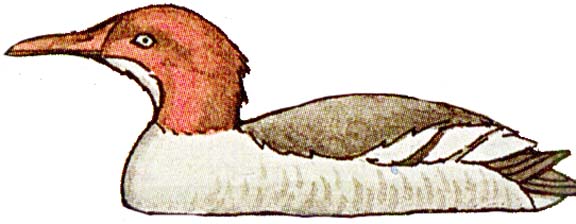

They breed in Alaska, across Canada to Newfoundland and southward to New Jersey, Minnesota, New Mexico, and California. They are also found in Eurasia all year long and into North Africa in the winter. They spend the winter in southern Canada south along the coasts and into North Carolina, across to Kentucky, Arkansas, and northern Mexico.
They live on streams, rivers, lakes, ponds and coastal waterways.
They have a dark green head, a bright white breast and sides and a long, thin, red bill, with a saw-like edge on both sides for eating fish.
They swim in small flocks, often facing upstream while they fish. They dive underwater to catch prey.
They eat small fish, insects, crayfish, worms, frogs, small mammals, birds, and plants.
They nest in a tree hole lined with down pulled from the chest of the female. She lays 6-17 creamy, white eggs.
Kingdom: Animalia
Phylum: Chordata
Subphylum: Vertebrata
Class: Aves
Order: Anseriformes
Family: Anatidae
Genus: Mergus
Species: M. merganser
When you research information you must cite the reference. Citing for websites is different from citing from books, magazines and periodicals. The style of citing shown here is from the MLA Style Citations (Modern Language Association).
When citing a WEBSITE the general format is as follows.
Author Last Name, First Name(s). "Title: Subtitle of Part of Web Page, if appropriate." Title: Subtitle: Section of Page if appropriate. Sponsoring/Publishing Agency, If Given. Additional significant descriptive information. Date of Electronic Publication or other Date, such as Last Updated. Day Month Year of access < URL >.
Amsel, Sheri. "Merganser (Common)" Exploring Nature Educational Resource ©2005-2024. December 14, 2024
< http://www.exploringnature.org/db/view/Merganser-Common >

